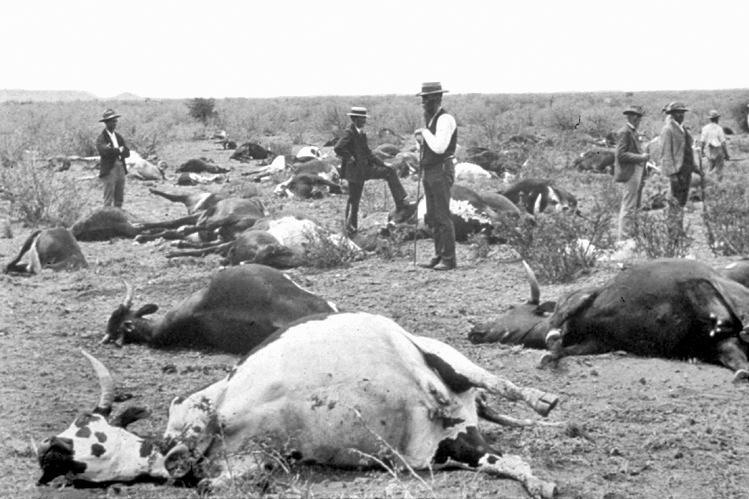1890s African rinderpest epizootic on:
[Wikipedia]
[Google]
[Amazon]
 In the 1890s, an
In the 1890s, an
 In the 1890s, an
In the 1890s, an epizootic
In epizoology, an epizootic (from Greek: ''epi-'' upon + ''zoon'' animal) is a disease event in a nonhuman animal population analogous to an epidemic in humans. An epizootic may be restricted to a specific locale (an "outbreak"), general (an "epi ...
of the rinderpest
Rinderpest (also cattle plague or steppe murrain) was an infectious viral disease of cattle, domestic buffalo, and many other species of even-toed ungulates, including gaurs, buffaloes, large antelope, deer, giraffes, wildebeests, and warthogs ...
virus struck Africa, considered to be "the most devastating epidemic to hit southern Africa in the late nineteenth century". It killed more than 5.2 million cattle south of the Zambezi
The Zambezi River (also spelled Zambeze and Zambesi) is the fourth-longest river in Africa, the longest east-flowing river in Africa and the largest flowing into the Indian Ocean from Africa. Its drainage basin covers , slightly less than hal ...
, as well as domestic oxen, sheep, and goats, and wild populations of buffalo, giraffe
The giraffe is a large African hoofed mammal belonging to the genus ''Giraffa''. It is the tallest living terrestrial animal and the largest ruminant on Earth. Traditionally, giraffes were thought to be one species, ''Giraffa camelopardalis ...
, and wildebeest
Wildebeest ( , , ), also called gnu ( or ), are antelopes of the genus ''Connochaetes'' and native to Eastern and Southern Africa. They belong to the family Bovidae, which includes true antelopes, cattle, goats, sheep, and other even-toe ...
. This led to starvation resulting in the death of an estimated third of the human population of Ethiopia
Ethiopia, , om, Itiyoophiyaa, so, Itoobiya, ti, ኢትዮጵያ, Ítiyop'iya, aa, Itiyoppiya officially the Federal Democratic Republic of Ethiopia, is a landlocked country in the Horn of Africa. It shares borders with Eritrea to the ...
and two-thirds of the Maasai people
The Maasai (; sw, Wamasai) are a Nilotic ethnic group inhabiting northern, central and southern Kenya and northern Tanzania. They are among the best-known local populations internationally due to their residence near the many game parks of t ...
of Tanzania
Tanzania (; ), officially the United Republic of Tanzania ( sw, Jamhuri ya Muungano wa Tanzania), is a country in East Africa within the African Great Lakes region. It borders Uganda to the north; Kenya to the northeast; Comoro Islands and ...
.
The famine significantly depopulated sub-Saharan Africa, allowing thornbush to colonise. This formed ideal habitat for tsetse fly
Tsetse ( , or ) (sometimes spelled tzetze; also known as tik-tik flies), are large, biting flies that inhabit much of tropical Africa. Tsetse flies include all the species in the genus ''Glossina'', which are placed in their own family, Glo ...
, which carries sleeping sickness
African trypanosomiasis, also known as African sleeping sickness or simply sleeping sickness, is an insect-borne parasitic infection of humans and other animals. It is caused by the species ''Trypanosoma brucei''. Humans are infected by two typ ...
, and is unsuitable for livestock.
The virus is thought to have been introduced into Eritrea
Eritrea ( ; ti, ኤርትራ, Ertra, ; ar, إرتريا, ʾIritriyā), officially the State of Eritrea, is a country in the Horn of Africa region of Eastern Africa, with its capital and largest city at Asmara. It is bordered by Ethiopia ...
in 1887 by Indian cattle brought by the Italians for their campaign against Somalia. It spread throughout the Horn of Africa
The Horn of Africa (HoA), also known as the Somali Peninsula, is a large peninsula and geopolitical region in East Africa.Robert Stock, ''Africa South of the Sahara, Second Edition: A Geographical Interpretation'', (The Guilford Press; 2004), ...
, and crossed the Zambezi
The Zambezi River (also spelled Zambeze and Zambesi) is the fourth-longest river in Africa, the longest east-flowing river in Africa and the largest flowing into the Indian Ocean from Africa. Its drainage basin covers , slightly less than hal ...
in March 1896.
Sir Arnold Theiler
Sir Arnold Theiler KCMG (26 March 1867 – 24 July 1936) Pour le Mérite is considered to be the father of veterinary science in South Africa. He was born in Frick, Canton Aargau, Switzerland. He received his higher education, and later qu ...
was instrumental in developing a vaccine that curbed the epizootic.
References
Further reading
* {{Africa-hist-stub Famines in Africa 1890s in Africa 1890s in Ethiopia 19th-century famines